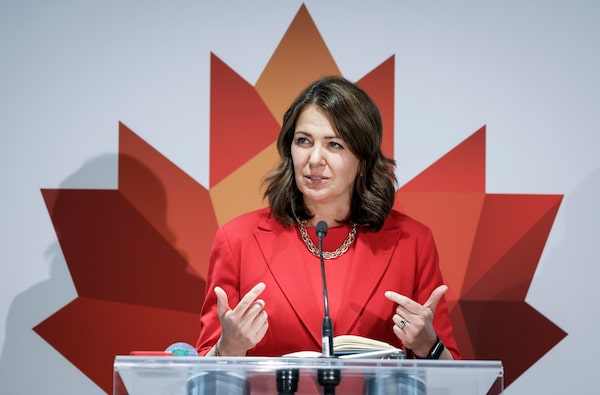High inflation. A complicated interest rate cycle. Alberta’s controversial pension plans. Netflix’s password sharing crackdown. Canada’s most livable cities. Rising mortgages payments. Recession fears. It’s safe to say that there has been no shortage of news this year.
In the final weekly digest of 2023, we’re taking a look back at The Globe’s most-read business and investing stories of the entire year. Get caught up on the biggest stories that resonated with readers on a variety of topics from housing, debt, critical minerals and more.
‘We’re barely making it’: Eight Canadian stories reveal the pain of soaring mortgage costs
Colin Tran wants to purchase a home, but can't afford high mortgage costs. Instead he's saving using the new First Home Savings Account.JASON FRANSON/The Globe and Mail
In a year of high inflation and housing unaffordability, Canadian homeowners were especially feeling the squeeze of interest rates. Irene Galea spoke to Canadians facing difficult decisions in order to continue paying off their loans. They’re deferring retirement, cutting back expenses and worrying about how they will cover their next mortgage payment. Some are even lengthening their mortgage amortization, stretching out the duration of their payments from 15 or 25 years to 30 years or beyond to keep their payments down. These are their stories.
Opinion: Netflix’s desperate crackdown on password sharing shows it might fail like Blockbuster
This photo shows a logo for Netflix on a remote control in Portland, Ore.Jenny Kane/The Associated Press
When Netflix announced in February that it would crack down on password sharing, Canadians users were left questioning whether it was still worth paying the subscription fee. In a column for The Globe and Mail, Ken Birch, director of the Institute for Technoscience and Society at York University, raises the question of whether the move – and Netflix’s business model and monetization strategy – is viable in the long-run. He writes: “Netflix is facing a self-defeating cycle with its subscription changes.” Fast forward to the end of the year, Netflix has reported strong third-quarter results and increased its subscriber base – sending shares surging.
The 100 most livable cities in Canada

Illustration by Kathleen Fu
One of The Globe’s popular stories of the year in general was the inaugural ranking of Canada’s 100 most livable cities. The data-driven list places an emphasis on key attributes that most Canadians value in their communities such as the economy, climate, safety and, yes, the cost of housing. The Canadian city that came in number one overall was Victoria, B.C. for its access to nature, mild sunny climate and dreamy seaside way of life. The top Canadian city for raising kids was Winnipeg, Man. because of its low cost-of-living and affordable housing. Mahima Singh and Chen Wang also created sub-rankings tailored to life stages such as young professionals, families raising kids, newcomers, entrepreneurs, retirees and more – to accommodate the evolving priorities across different stages of life.
Opinion: Danielle Smith’s plan to withdraw from CPP would leave all Canadians – including Albertans – poorer

Alberta Premier Danielle Smith speaks to the media in Calgary, Alta., on Sept. 18.Jeff McIntosh/The Canadian Press
In September, Alberta Premier Danielle Smith said the province will pursue plans to leave the Canada Pension Plan and instead push to set up an alternative provincial pension system. In a column for The Globe and Mail, Andrew Willis writes that this plan would leave all Canadians – including Albertans – poorer. He writes: “Every investment professional in the country knows this concept, as envisioned by the Premier, is a really bad idea.” He also writes that even if Ms. Smith is successful in creating a provincial pension plan, the resulting fund would be far smaller than what the premier has promised. Read the full column on Alberta’s pension plan.
Wayne Gretzky’s rookie card is the Holy Grail of Canadian sports collectibles – and I own one
A variety of Wayne Gretzky hockey cards owned by Jason Martin of Martin Sports Cards, are on display at the Sport Cards and Memorabilia Expo, in Mississauga, Ont.Christopher Katsarov/The Globe and Mail
Wayne Gretzky’s rookie card is the most valuable card ever produced on Canadian soil. In fact, Dave Parkinson describes it as “the Holy Grail of Canadian sports collectibles” – and he happens to owns one. The card, which was produced by Canadian company The O-Pee-Chee Company, Ltd. and marks The Great One’s rookie year, is a centrepiece of multimillion-dollar sports-card auctions across the world. The Globe columnist set out to find more about the special card from his childhood, including where it came from, how it was made, and why someone would spend millions of dollars to own it. Read about his journey.
Canada wants to be a global leader in critical minerals. Why is Australia eating our lunch?
View of the Rio Tinto Alcan smelter in Kitimat, B.C.Felipe Fittipaldi/The Globe and Mail
The Globe launched its Mission Critical series this year, which looks at the issues around whether Canada can become a mining superpower in critical minerals. The first story of the series explores how foreign companies have built a dominant position in Canada’s critical minerals sector – and few have benefited more than Australia. Niall McGee takes a look at how Canadian policies around foreign investment present an existential threat for domestic mining companies here. The series also dives into themes such as money challenges and supply chain challenges for EV batteries.
How does your debt compare to Canadians your age? Find out with this calculator

Photo illustration by The Globe and Mail/iStockPhoto / Getty Images
How much debt is each generation of Canadians carrying, and how do you compare? In January, personal finance columnist Rob Carrick launched an anonymous survey in his Carrick on Money newsletter asking readers questions about their debt. He analyzed the survey results from more than 6,150 people – aged 18 to 29, 30 to 39 and so on, up to 70-plus – and the data was used to create a calculator. The numbers help to pinpoint which generations carry the most debt (on average), how much people owe (on average) and how common it is to have various types of debt at particular ages – because, as he writes, “the reality of life in today’s world is that people from all generations are borrowers.”
 Abigale Subdhan
Abigale Subdhan